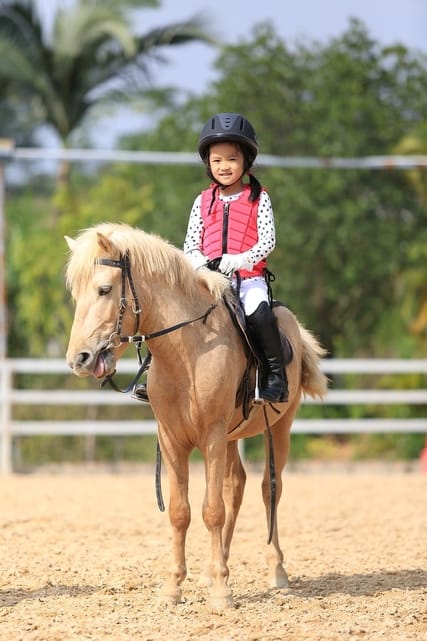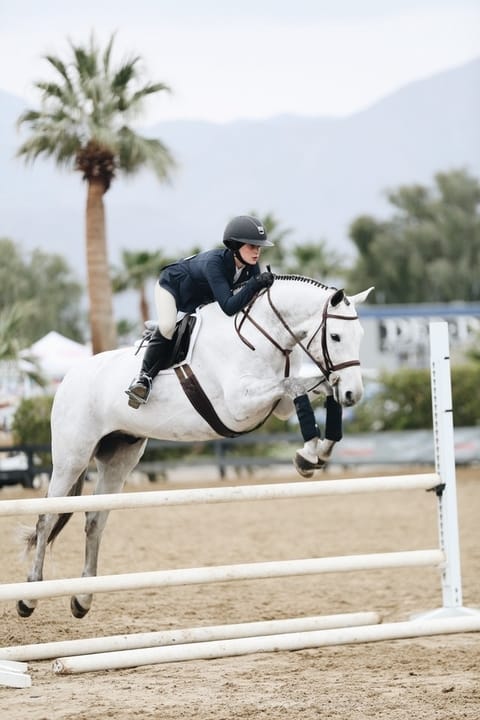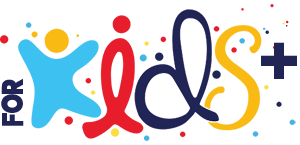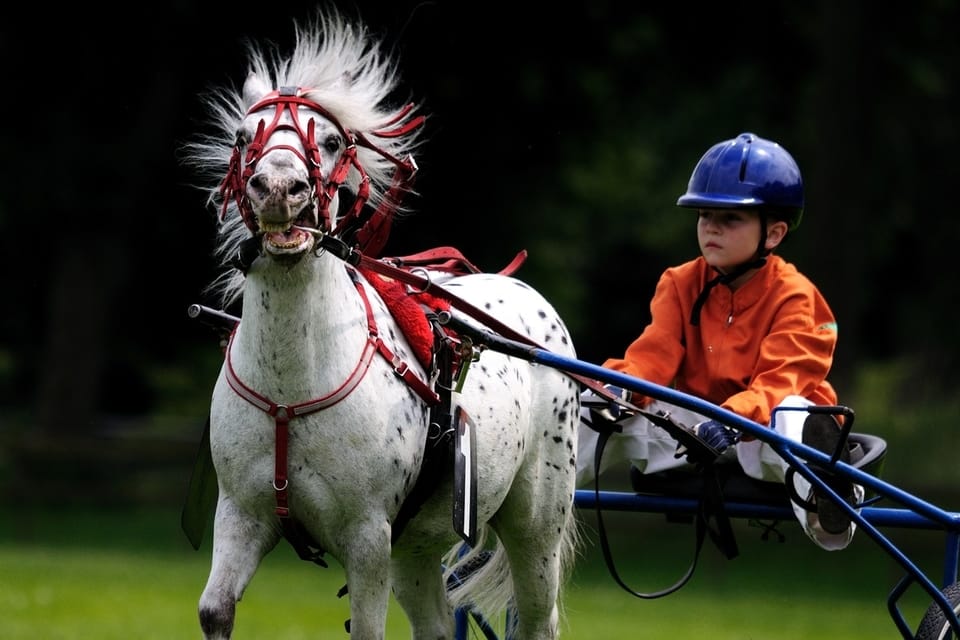If you’re searching for an exciting sport that’s at the same time useful for your kids, you can’t find an activity that’s better than horse riding for kids.
Equestrian sport for children is one of the most challenging games that can also have many benefits for your kids.
It’s actually an ancient activity. The first competitions for it were held in Dublin, in 1868.
In 1912, it was included in the program of the Olympic Games. It’s not surprising that in the 21st century, this sport has become promising for the younger generation.
Today, For Kids will examine the main points you need to know about horseback riding for kids, including the basic rules and the best age for the kids to start this sport.
Also, you’ll learn about:
- The benefits and disadvantages
- Potential medical contraindications
- The cost of horseback riding lessons
- How to choose suitable riding lessons and more!
Horse riding for kids
Table of Contents
- 1. Types of horse riding competitions
- 2. Best age
- 3. Benefits
- 4. Disadvantages
- 5. Medical contraindication
- 6. Cost
- 7. Choose academy
- 8. Summary
- 9. References
Types of horse riding competitions
There are many types of horseback riding competitions. Only eight types are held under the control of the International Federation for Equestrian Sports (FEI).
From these eight types, only three equestrian disciplines are a part of the summer Olympic program.
a. Olympic Equestrian competitions
1. Show jumping
Jumping is a type of equestrian sport associated with overcoming obstacles over a specific distance (from 200 to 1100 meters).
The rider has to pass 12 to 20 fences, which can be knocked down (unlike cross-country jumping’s fixed obstacles), within time limits.
2. Dressage
Dressage is a demonstration of the horse’s obedience, rhythm and balance, and its level of harmony with the rider.
3. Eventing
This is a combination of three different disciplines in a one-day event or a three-day event.
The three disciplines are:
- Show jumping,
- Dressage
- Cross-country jumping
b. Non-Olympic horseback riding races
1. Endurance riding
A long-distance race that ranges from 50 to 100 miles (80 to 160 kilometers), over mountains or other natural terrain.
2. Vaulting
This involves performing gymnastics and dance on horseback.
3. Reining
A Western riding competition for horses, during which the riders guide the horses through a precise pattern of spins, circles and stops.
All work is done at the pace of a lope or gallop.
4. Combined driving
A single horse, a pair of horses or a group of four horses pulls a vehicle controlled by a rider.
This type of race has three phases: Dressage, cross-country marathon and obstacle cone driving.
Best age to start horse riding for kids
The best age to start horseback riding sports for kids is five to six years, as the main requirement of any pony club for the reception of a child is the ability to reach the stirrups with their feet. On average, this ability comes at the age of five or six years.
Of course, this all depends on the goal you are pursuing. If you want a child to be professionally involved in equestrian sports, then you must send them to lessons at an earlier age.
Purposeful training to ride a horse is recommended, to start, from the age of eight. This involves enrolling in special sections of a pony club.
Normally, at this age, kids have already begun to behave responsibly and they realize the importance of communicating with such an animal as a horse.
At the same time, for specialized training, the kids should be accustomed to equestrian sports from an earlier age, for example, from the age of four.
Under the supervision of adults, small children can sit on a horse, holding tightly onto the saddle and the mane. While they do so, an adult shouldn’t give up control of any of the horses that are being used for this purpose.
How to discover if a toddler will love horseback riding:
At an earlier age, a toddler can be taken on a tour of a stable, a horse riding competition, a contact zoo, or a similar space.
You can also read fairy tales with your child that involve horses, or tell them other interesting stories and show them pictures of the animal.
With this, it’s possible to discover the manifestation of interest in the child. The main thing is not to be intrusive. The child should come to love this sphere of interest on their own.
Benefits of horse riding sports for kids
There are many advantages to having your child engage in horseback riding as a sport. Here are some of the most important benefits:
1. Co-ordination
While riding a horse, kids need to do many movements simultaneously.
This will enhance the harmony of their muscle movement and improve their hand-eye coordination.
Therapeutic riding programs for kids with sight impairment and cerebral palsy have had a lot of success with developing better co-ordination in the children.
2. Muscle power and flexibility
Riding a horse is an active process. Sometimes the horse’s movements will become unpredictable and the child will have to manage these changes.
At all times, the rider must use the following muscle groups: the back, the abdominals, the calves and the adductor muscles of the thigh.
The effect that horse riding has on the muscles is difficult to achieve just with simple visits to the gym.

3. Physical development
Horseback riding improves a child’s body balance, core strength, hand-eye coordination, motor coordination and muscular development.
4. Character formation
Kids who spend a lot of time with a horse become more open to the world, kind, understanding and calm.
The process of riding a horse teaches the kids to manage a large animal. Therefore, the child hardens their character, becoming more responsible, and independent.
5. Self-confidence development
As kids make progress with their in horse riding skills, their self-confidence and self-assurance will develop incredibly.
6. Emotional benefits
The young riders will learn to face their fears and uncertainty and act confidently.
7. Discipline
Riding sports such as horseback riding will help increase your kid’s patience levels.
They’ll teach a child about self-discipline, including how to focus and control themselves.
8. Hippotherapy
Hippotherapy is a trend in medicine that refers to the use of horse movements as a treatment tool.
Hippotherapy engages the client in activities on the horse that are enjoyable and challenging in order to address impairments, functional limitations and disabilities in patients with neuromusculoskeletal dysfunction.
Hippotherapy is used to treat patients with neurological disabilities, such as autism, arthritis, cerebral palsy, multiple sclerosis, strokes, spinal cord injuries, head injuries, behavioural disorders and psychiatric disorders.
See the references at the bottom for more details about hippotherapy.
Disadvantages of horseback riding for kids
1. It’s a dangerous sport
A horse is a living being and is sometimes uncontrollable, but how dangerous, exactly, is horseback riding?
There are many cases in which a “harmless” animal has been the cause of a disaster. Parents who want to get their babies into this sport should know that.
A horse can feel fear and negative emotions. While they’re in this state, it’s important for kids to be able to control them and not show their weaknesses to the animal.
This will help prevent the horse from being disobedient.
However, with all this being said, keep in mind that if your children join a reputable horseback riding school, the risk of injuries is almost non-existent.
2. It’s expensive
It is necessary to pay not only for learning to ride a horse, but also for your equipment.
Your equipment that must be purchased will include jackets, vests, breeches, special shoes, helmets, gloves and more. The list is big!
Many parents buy horses for their kids. In these cases, purchasing horse equipment is still necessary.
Equipment is important when it comes to avoiding injury to a horse. In addition to the saddle, riders must buy bits, rugs, bridles, reins, headcollars and lead ropes.
3. Medical contraindications
The key disadvantages of equestrian sports are primarily tied to medical contraindications.
Horse riding can harm the health of hypertensive children. During shaking, which occurs while they’re riding a horse, blood pressure can increase and lead to a failure in cardiac activity.
Riding horses is also dangerous for children with soft bone tissue.
More about medical contraindications of equestrian for kids
- It is categorically impossible to get involved in even ordinary horseback riding, not only for children but also for adults who are suffering from cardiovascular diseases.
These include heart disease, a past stroke or heart attack, arterial hypertension and more.
During horse riding, blood pressure and the heartbeat increases, which can lead to negative consequences for these individuals. - Kidney disease and diseases of the pelvic organs are exacerbated when a person is riding a horse. This is due to rhythmic shaking.
- Despite the fact that horseback riding is useful for people with diseases of the nervous system, equestrian sport should be abandoned by children who are suffering from severe phobias, for example, a fear of heights.
The average cost of horseback riding lessons and equipment
1. Cost of equestrian lessons

The cost of equestrian sports varies, depending on the region in which your child plans to study, as well as the duration of their training and their level of training.
Classes are divided into private and group lessons. The first type will be more expensive, as the coach will pay all of their attention to one child.
The average cost of one-hour lessons for groups of three or more, at many equestrian centres, is $30 to $50 per person.
Individual horse-riding lessons cost up to $70 or $80 for a one-hour lesson.
2. Cost of equestrian equipment
If you use a school’s horses and won’t buy your own horse, you’ll still have to purchase personal equipment for your kids’ safety.
You’ll be looking at the following items:
- Proper shoes: It’ll cost around $50 for basic, usable boots such as paddock boots and/or half-chaps.
- A helmet: Never buy a used one, as this is a safety issue. You can find a lot of affordable equestrian helmets online.
- Gloves: You can get a pair for $10.
- Clothing: Long pants like jeans, breeches, or jodhpurs are available for around $40.
3. Other costs
You must also pay for competitions and transportation.
Additionally, you’ll have to pay a lot of money if you decide to buy a horse for international competitions, along with buying its equipment.
Tips for choosing the best horseback riding lessons
When selecting a school of equestrian sport for your kids, parents should take into account the following points:
1. The skill of the coach
The skill of the coach is certainly a point that is worth taking into account, as the coach will be with your child during the whole process of learning to ride a horse.
The trainer’s experience in handling the horse itself is important.
Be sure to find out how long they’ve been working in their field. Be interested in their personal achievements.
Ask for documents related to the passage of specialized courses and professional development activities.
It’s important to the ability of a coach that they can find a common language with the children they teach.
The coach should be a sort of psychologist who knows how to set the child on the right track. Also, the coach must be somewhat strict so that the kids can make progress.
2. The choice of horses available
Each school will offer horses of different breeds. If the child is small (four to six years old), then a pony, which is a horse of short height, will suit them.
For older children, choosing horses will depend on the type of horseback riding they’ll engage in.
Abyssinian, Brazilian sport horses, Irish sport horses and Cleveland Bay breeds are very suitable for equestrian sports, especially for show jumping, dressage and eventing.
3. The distance of the school or club from home
This is an important factor, especially in big cities, as you can have more than one horse riding academy near you.
4. The tuition fees
Watch your budget and choose the most suitable horseback riding lessons for you after taking it into account.
5. The club’s specialty
Review the specialty of the horse riding club, as some equestrian academies focus on one type of horse riding only.
If the child doesn’t have any experience, it’s necessary that they start practicing in a club where they can practice different types of horse riding.
You should also pay attention to the number of other children who study in the group. Typically, the cost of education is proportional to the total number of students.
Summary
Riding horses for kids is one of the most challenging—but at the same time, exciting—sports.
Having given your child over to the equestrian sport, you won’t regret it, because your kids will receive a lot of bonuses, including but not limited to:
- An improved mood
- Higher self-esteem
- More independence
- Better immunity
- Enhanced posture
- The toning of important muscular groups
However, you shouldn’t lose sight of the fact that equestrian sports are one of the most expensive sports.
Carefully weigh the pros and cons before making your final decision about this sport.
The main thing that should be taken into account is the desire of your kids and their love for horses.
If this is observed in your family, then the decision is obvious: start the lessons!
References

